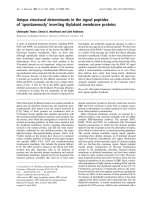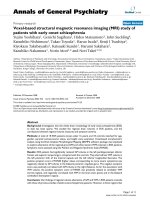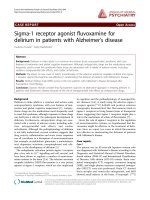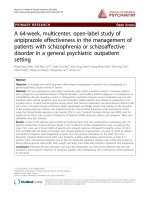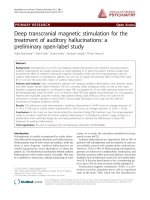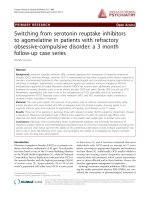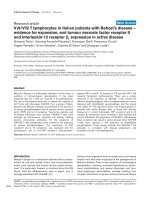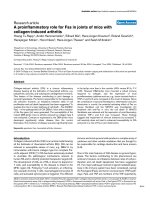Báo cáo y học: "Voxel-based structural magnetic resonance imaging (MRI) study of patients with early onset schizophrenia" potx
Bạn đang xem bản rút gọn của tài liệu. Xem và tải ngay bản đầy đủ của tài liệu tại đây (384.82 KB, 11 trang )
BioMed Central
Page 1 of 11
(page number not for citation purposes)
Annals of General Psychiatry
Open Access
Primary research
Voxel-based structural magnetic resonance imaging (MRI) study of
patients with early onset schizophrenia
Yujiro Yoshihara
1
, Genichi Sugihara
2
, Hideo Matsumoto
3
, John Suckling
4
,
Katsuhiko Nishimura
1
, Takao Toyoda
1
, Haruo Isoda
5
, Kenji J Tsuchiya
2
,
Kiyokazu Takebayashi
1
, Katsuaki Suzuki
2
, Harumi Sakahara
5
,
Kazuhiko Nakamura
1
, Norio Mori
1,2
and Nori Takei*
2,6
Address:
1
Department of Psychiatry and Neurology, Hamamatsu University School of Medicine, Hamamatsu, Japan,
2
Osaka-Hamamatsu Joint
Research Center for Child Mental Development, Hamamatsu, Japan,
3
Department of Psychiatry and Behavioral Sciences, Tokai University School
of Medicine, Isehara, Japan,
4
Brain Mapping Unit, Department of Psychiatry, University of Cambridge, Addenbrooke's Hospital, Cambridge, UK,
5
Department of Radiology, Hamamatsu University School of Medicine, Hamamatsu, Japan and
6
Division of Psychological Medicine, Institute of
Psychiatry, King's College, University of London, London, UK
Email: Yujiro Yoshihara - ; Genichi Sugihara - ; Hideo Matsumoto -
tokai.ac.jp; John Suckling - ; Katsuhiko Nishimura - ; Takao Toyoda - ;
Haruo Isoda - ; Kenji J Tsuchiya - ; Kiyokazu Takebayashi - ;
Katsuaki Suzuki - ; Harumi Sakahara - ; Kazuhiko Nakamura - nakamura@hama-
med.ac.jp; Norio Mori - ; Nori Takei* -
* Corresponding author
Abstract
Background: Investigation into the whole brain morphology of early onset schizophrenia (EOS)
to date has been sparse. We studied the regional brain volumes in EOS patients, and the
correlations between regional volume measures and symptom severity.
Methods: A total of 18 EOS patients (onset under 16 years) and 18 controls matched for age,
gender, parental socioeconomic status, and height were examined. Voxel-based morphometric
analysis using the Brain Analysis Morphological Mapping (BAMM) software package was employed
to explore alterations of the regional grey (GM) and white matter (WM) volumes in EOS patients.
Symptoms were assessed using the Positive and Negative Syndrome Scale (PANSS).
Results: EOS patients had significantly reduced GM volume in the left parahippocampal, inferior
frontal, and superior temporal gyri, compared with the controls. They also had less WM volume in
the left posterior limb of the internal capsule and the left inferior longitudinal fasciculus. The
positive symptom score of PANSS (higher values corresponding to more severe symptoms) was
negatively related to GM volume in the bilateral posterior cingulate gyrus. The negative symptom
score was positively correlated with GM volume in the right thalamus. As for the association with
WM volume, the positive symptom score of PANSS was positively related to cerebellar WM
(vermis region), and negatively correlated with WM in the brain stem (pons) and in the bilateral
cerebellum (hemisphere region).
Conclusion: Our findings of regional volume alterations of GM and WM in EOS patients coincide
with those of previous studies of adult onset schizophrenia patients. However, in brain regions that
Published: 22 December 2008
Annals of General Psychiatry 2008, 7:25 doi:10.1186/1744-859X-7-25
Received: 4 October 2008
Accepted: 22 December 2008
This article is available from: />© 2008 Yoshihara et al; licensee BioMed Central Ltd.
This is an Open Access article distributed under the terms of the Creative Commons Attribution License ( />),
which permits unrestricted use, distribution, and reproduction in any medium, provided the original work is properly cited.
Annals of General Psychiatry 2008, 7:25 />Page 2 of 11
(page number not for citation purposes)
had no overall structural differences between EOS patients and controls (that is, the bilateral
posterior cingulate gyrus, the right thalamus, the cerebellum, and the pons), within-subject analysis
of EOS patients alone revealed that there were significant associations of the volume in these areas
and the symptom severity. These findings suggest that at an early stage of the illness, especially for
those with onset before brain maturation, a wide range of disturbed neural circuits, including these
brain regions that show no apparent morphological changes, may contribute to the formation of
the symptomatology.
Background
Schizophrenia is a mental disorder with typical onset in
early adulthood [1]. Although the disorder has also been
identified in children and early adolescents, such occur-
rences are rare [2,3]. Several studies have gathered and
scrutinised brain samples from early onset schizophrenia
(EOS) patients in various domains. In particular, since
brain morphological abnormalities are consistently found
in the general samples of patients with schizophrenia
(that is, adult onset populations), researchers have
focused on the exploration of brain morphology in
patients with EOS, defined herein as schizophrenia with
onset under age 18 [4-6]. Using magnetic resonance imag-
ing (MRI), some research groups have reported enlarge-
ment of the lateral ventricles [7,8], and regional volume
reduction in the superior temporal gyrus [9,10], thalamus
[8,11,12], and frontal lobe [12-14] in EOS patients, mir-
roring findings reported in individuals with adult onset
schizophrenia (AOS) [15-17]. However, compared with
AOS studies, the number of EOS studies, especially by sep-
arate research groups, is still small, and thus studies using
an independent sample of EOS patients are in demand.
Previous studies of AOS patients have reported the rela-
tionships between structural brain volume alterations,
and positive and negative symptoms in various brain
regions, such as the superior temporal gyrus [18-20],
insula [21], fusiform gyrus [20], parahippocampal gyrus
[22], basal ganglia [23], and prefrontal gyri [24]. As for
EOS patients, a few studies have investigated the relation-
ships between regional brain changes and the symptom
severity, and the regions found to be related to the symp-
toms in EOS patients, such as the hippocampal [5], occip-
ital, and parietal cortices [25], are not entirely consistent
with the reports on AOS patients.
Brain development in early life is thought to be dynamic,
with the patterns of growth being diverse across different
brain regions [26]. In particular, brain regions that are
inherently linked with the pathology of schizophrenia
may undergo disproportional changes during the vulner-
able period of brain development (that is, the period
before adolescence) [27,28]. In the present study, we con-
ducted voxel-based structural MRI analyses to explore any
pattern of regional brain tissue volume abnormalities,
and to elucidate the relationships between the regional
brain volume and the severity of clinical symptoms in
EOS patients.
Methods
Recruitment of participants
Patients who fulfilled Diagnostic and Statistical Manual of
Mental Disorders, 4th edition (DSM-IV) [29] criteria for
schizophrenia and who had been under the age of 18
years at onset [4-6] were recruited from among inpatient
and outpatient facilities at the Hamamatsu University
Hospital and associated hospitals in the city of Hama-
matsu, Japan. In all, 18 patients with onset equal to or
below 16 years participated in the study. A total of 18
healthy control participants were recruited from the com-
munity in Hamamatsu by way of posted advertisement
and word of mouth. They were matched to the patients for
age, gender, parental socioeconomic status, and height.
Participants in both the EOS and control groups were
excluded if they had: (1) any current neurological disor-
ders or family history of hereditary neurological disorders,
(2) a history of head injury resulting in loss of conscious-
ness, (3) alcohol or substance abuse, or (4) metallic
objects in their body (exclusion criterion for MRI).
Patients were also excluded if they had any comorbid
DSM-IV axis I disorder. The study was approved by the
Ethics Committee of the Hamamatsu University School of
Medicine. After a complete description of the study to
each participant and his or her parents, written informed
consent was obtained.
Clinical assessments
Diagnosis was made on the basis of interviews by two
trained psychiatrists (one of whom was a child psychia-
trist), along with reference to medical records and infor-
mation from family members and attending physicians.
The dose and duration of medication were also recorded.
Age at onset of schizophrenia was defined as the age when
patients first clearly manifested either delusions, halluci-
nations, or thought disorders. Psychopathology was
assessed with the Positive and Negative Syndrome Scale
(PANSS) [30]. Diagnosis was established with the Struc-
tured Clinical Interview for DSM-IV (SCID) [31]. For
those participants under the age of 16, the interview was
supplemented by the KID SCID [32]. Parental socioeco-
Annals of General Psychiatry 2008, 7:25 />Page 3 of 11
(page number not for citation purposes)
nomic status was determined according to the Standard
Occupational Classification [33], and handedness was
determined by self-report. Statistical significance was set
at p < 0.05 for clinical comparisons, and for the volume
measures (two-tailed).
MRI acquisition
All participants were scanned with a GE Signa 1.5-T sys-
tem (GE Medical Systems, Milwaukee, WI, USA) at the
Hamamatsu University School of Medicine. A preliminary
localising scan in the coronal plane was used to identify
anterior and posterior commissures, and to prescribe
acquisition of a dual echo fast spin echo dataset in a plane
parallel to the intercommissural line. Contiguous, inter-
leaved proton density- and T2-weighted images, each 3-
mm thick, were obtained to provide whole brain cover-
age. The repetition time (TR) was 4000 ms, and echo
times (TE) were 14 and 84 ms with an 8-echo train length.
The matrix size was 256 × 192 collected from a rectangular
field of view of 24 cm × 18 cm, giving an in-plane resolu-
tion of 0.859 mm. The total acquisition time was 9 min 36
s.
Data analysis
Group differences in grey and white matter were assessed
using the Brain Analysis Morphological Mapping
(BAMM) software package chia
try.cam.ac.uk/software. This process has previously been
described in detail for both adult and child populations
[23,34,35]. Briefly, images were processed to remove
extracerebral tissues [36], and then segmented into grey
and white matter, cerebrospinal fluid (CSF) and a fourth
class including dura, vessels, and other extraneous tissues
which were subsequently ignored [37]. Global volumes of
grey and white matter, CSF, and whole brain (grey and
white matter plus CSF) were calculated and compared
across groups using independent t tests with the level of
significance set at p < 0.05. The segmented images were
mapped into the standard space of Talairach and
Tournoux [38] by minimising the sum of the square
intensity differences between each proton density image
and a template and applying the derived mappings to the
segmented tissue maps. All maps were smoothed with a
Gaussian kernel of 2 mm standard deviation [37].
Between-group differences in grey matter volume and
white matter volume were estimated by fitting an analysis
of covariance (ANCOVA) model at each intracerebral
voxel in standard space, which included the age at scan,
sex, and whole brain volume as covariates. Maps of the
appropriate normalised coefficient were subject to an
inference procedure in which the significance of a three-
dimensional cluster statistic was assessed using non-para-
metric methods [39]. The statistical thresholds were cor-
rected for multiple comparisons by controlling the
'family-wise error rate', in this case by setting the p value
used such that < 1 false-positive cluster was expected
under the null hypothesis [39]. A cluster of grey or white
matter abnormality was defined as a deficit or an excess
depending on whether the volume was reduced or
increased in the EOS group relative to the control group.
Within the patient group, the relationships between grey
and white matter volume and positive, negative and glo-
bal score (PANSS) were estimated by fitting a regression
model at each intracerebral voxel in standard space for
each tissue class separately.
When the assumptions of the parametric methods are not
guaranteed, the non-parametric methods provide the only
analysis that can be considered valid and exact. As the dis-
tribution of the structural data derived from MRI scans
may violate the assumptions, such as normal distribution,
we thus employed non-parametric methods in this study.
Results
Demographic and clinical characteristics
The EOS and healthy control groups were similar as
regards the distribution of age, sex, ethnicity, social class,
and height (Table 1). All participants were right-handed.
Healthy controls had a significantly (p < 0.001) higher
mean IQ than the patients. In all, 17 EOS patients had
received antipsychotic medication, and 1 EOS patient had
never received antipsychotic medication.
Brain and CSF volumetric measures
Global volumes for the whole brain and each of the three
main tissue classes (grey matter, white matter, and CSF)
are shown in Table 2. In the EOS group, grey matter (GM)
volume was 5.5% smaller and white matter (WM) volume
was 3.9% smaller than in the control group, whereas CSF
volume in the EOS group was 11.5% larger than in the
control group. The differences in GM and CSF between
the two groups were significant (p < 0.032 and 0.008,
respectively), but the difference in WM was not (p < 0.12).
In addition, EOS patients had a significantly (4.0%; p <
0.009) smaller GM to whole brain ratio and significantly
(15.4%; p < 0.001) larger CSF to whole brain ratio com-
pared with the controls.
Regional grey matter (GM) and white matter (WM)
alterations in EOS patients
The EOS group had a significantly smaller GM in the left
parahippocampal gyrus (Brodmann's area: 34), the left
inferior frontal gyrus (Brodmann's area: 47), and the left
superior temporal gyrus (Brodmann's area: 22), com-
pared with the control group (Figure 1, Table 3). The EOS
group also had significantly less WM in the left posterior
limb of the internal capsule, and the left inferior longitu-
dinal fasciculus (Figure 2, Table 3).
Annals of General Psychiatry 2008, 7:25 />Page 4 of 11
(page number not for citation purposes)
Association between symptoms and volumetric measures
(GM and WM) in EOS patients
The positive symptom score of PANSS (with higher values
in the PANSS corresponding to more severe symptoms)
was negatively related to GM volume in the bilateral pos-
terior cingulate gyrus (Figure 3, Table 4). The negative
symptom score was positively correlated with GM volume
in the right thalamus (Figure 4, Table 4). As for the asso-
ciation with WM volume, the positive symptom score of
PANSS was positively related to cerebellar WM (vermis
region), and negatively correlated with WM in the brain
stem (pons) and in the bilateral cerebellum (hemisphere
region) (Figure 5, Table 4). We found no significant asso-
ciation between regional WM volume change and the neg-
ative symptom score of PANSS.
Discussion
To our knowledge, this is the first voxel-based morphom-
etry study indicating significant relationships between
regional brain volume alterations and clinical symptoms
in EOS patients (that is, with onset under 16 years). We
found a significant GM volume reduction and a signifi-
cant increase of CSF in EOS patients. The EOS patients
had a significant reduction of regional GM in the left para-
hippocampal gyrus, the left inferior frontal gyrus, and the
left superior temporal gyrus. In addition, they had
reduced regional WM in the left posterior limb of the
internal capsule, and in the left inferior longitudinal fas-
ciculus. When the correlations between regional GM vol-
ume and positive symptoms were examined within the
EOS patient group, positive symptoms were found to be
significantly correlated with the reduced GM volume in
the bilateral posterior cingulate gyrus, with the increased
WM volume in the cerebellum (vermis region), and with
the reduced WM volume in the brain stem and the bilat-
eral cerebellum (hemisphere region). We also found a
relationship between the severity of negative symptoms
and the increased GM volume in the right thalamus.
The findings of a GM volume reduction and CSF increase
in individuals with EOS in this study are compatible with
previous volumetric studies of both EOS and adult onset
schizophrenia (AOS) patients [7,13,28,40-42], suggesting
that the pattern of volumetric alterations (that is, GM vol-
ume reduction and CSF increase) may be an inherent fea-
ture of schizophrenia irrespective of age at onset. The GM
volume reduction in schizophrenia as a whole could
Table 1: Subject characteristics
Variable Healthy controls
(n = 18)
EOS patients
(n = 18)
p Value
Age (years)
a
15.8 (1.3) 15.8 (1.8) 0.693
Sex (male/female)
b
9/9 9/9 1.00
Social class 1–3
b
16 (89%) 14 (78%) 0.371
Height (cm)
a
163.6 (7.1) 158.8 (8.6) 0.085
IQ
a
97.3 (11.8) 72.8 (15.3) 0.001
Duration of illness (years) - 1.2 (0.9) -
Positive and Negative Syndrome Scale:
Positive score - 13.8 (4.4) -
Negative score - 19.1 (10.0) -
Global score - 31.1 (10.7) -
Values are given as the mean (SD), except for sex and social class.
a
Two-tailed t test;
b
χ
2
test.
EOS, early onset schizophrenia; SD, standard deviation.
Table 2: Global brain volumes
Global brain volumes Control group
a
(n = 18)
EOS group
a
(n = 18)
Group difference
(%)
tp Value
Whole brain (ml) 1,325.7 (106.4) 1,290.0 (47.4) 2.7 (Control > EOS) 1.302 0.205
Grey matter (ml) 657.2 (60.4) 621.3 (29.5) 5.5 (Control > EOS) 2.271 0.032
White matter (ml) 496.5 (46.9) 476.9 (19.7) 3.9 (Control > EOS) 1.638 0.115
CSF (ml) 172.0 (20.3) 191.8 (21.9) 11.5 (EOS > Control) -2.813 0.008
Grey matter/whole brain ratio 0.50 (0.01) 0.48 (0.02) 4.0 (Control > EOS) 2.814 0.009
White matter/whole brain ratio 0.37 (0.01) 0.37 (0.01) 0 1.314 0.199
CSF/whole brain ratio 0.13 (0.02) 0.15 (0.01) 15.4 (EOS > Control) -3.507 0.001
a
Values are given as the mean (SD).
CSF, cerebrospinal fluid; EOS, early onset schizophrenia; SD, standard deviation.
Annals of General Psychiatry 2008, 7:25 />Page 5 of 11
(page number not for citation purposes)
reflect an exaggeration of a normal maturational process
of synaptic/dendritic pruning during adolescence [28].
The voxel-based analysis revealed that in the EOS group,
the regional volume reduction of GM was evident in the
left parahippocampal gyrus, the left inferior frontal gyrus,
and the left superior temporal gyrus. These findings were
consistent with those of the previous studies in patients
with AOS [15,43-45]. However, because regional grey
matter alterations have frequently been observed in vari-
ous brain regions of AOS patients, rather than being lim-
ited to these three brain regions alone [15], and because
grey matter abnormalities are deemed to be a fundamen-
tal part of the pathophysiology of schizophrenia, the
observation of grey matter changes in these three regions
(that is, the parahippocampal, inferior frontal, and supe-
rior temporal gyrus) in individuals with EOS in the
present study may indicate that the disease originates in
these areas. Another possible explanation is that these
three regions may be more subject to brain insults that are
related to the predisposition to schizophrenia.
We also found white matter morphological changes in
EOS patients. The reduction of WM volume was located in
the left posterior limb of the internal capsule, and the left
inferior longitudinal fasciculus. Although no prior study
has addressed the regional WM volume alterations in
EOS, the current findings are similar to those reported by
Sigmundsson et al. [23], who investigated WM volume
changes in AOS patients. In addition, diffusion tensor
imaging (DTI) studies of AOS [46] and EOS [47] patients
have also shown WM abnormalities in similar regions.
Table 3: Grey and white matter regional differences between early onset schizophrenia (EOS) group and control group
Area Brodmann area Talairach coordinate of centroid voxel (mm) Number of voxels in cluster
xyz
Control > EOS in grey matter:
Left parahippocampal gyrus, 34/47/22 -57 2 -4 423
Left inferior frontal gyrus,
Left superior temporal gyrus
Control > EOS in white matter:
Left posterior limb of internal
capsule
-20-8-8 418
Left inferior longitudinal fasciculus
Grey matter regional differences between early onset schizophrenia group (n = 18) and control group (n = 18)Figure 1
Grey matter regional differences between early onset schizophrenia group (n = 18) and control group (n = 18).
Blue regions denote areas of grey matter deficits in the early onset schizophrenia group relative to the control group. The left
side of the figure represents the right side of the brain; the z coordinate for each axial slice in the standard space of Talairach
and Tournoux [38] is given in mm. Cluster-wise probability of type I error: p = 0.001, with less than one false-positive cluster
expected over the whole map.
Annals of General Psychiatry 2008, 7:25 />Page 6 of 11
(page number not for citation purposes)
Therefore, there is evidence emerging from a variety of
sources to suggest that WM abnormalities are part of the
patterns of brain parenchymal aberration associated with
schizophrenia, although they may be a secondary process.
In addition, we found a relationship between the brain
stem (pons) volume reduction and positive symptoms.
This may be intriguing in view of the evidence, from a pos-
itron emission tomography (PET) study, showing dysreg-
ulation of dopaminergic transmission in the midbrain in
schizophrenia [48].
In our sample of EOS patients, the brain region that was
found to be associated with the severity of the positive
symptoms was the posterior cingulate gyrus. Although
similar findings have been reported in AOS patients [49],
most AOS studies have shown an association with other
brain regions, such as the superior temporal gyrus [18-
20], insula [21], fusiform gyrus [20], and parahippocam-
pal gyrus [22]. It is of note, however, that the region of the
posterior cingulate gyrus has also been reported to be
associated with the positive symptoms in other neuroim-
White matter regional differences between early onset schizophrenia group (n = 18) and control group (n = 18)Figure 2
White matter regional differences between early onset schizophrenia group (n = 18) and control group (n =
18). Blue regions denote areas of white matter deficits in the early onset schizophrenia group relative to the control group.
The left side of the figure represents the right side of the brain; the z coordinate for each axial slice in the standard space of
Talairach and Tournoux [38] is given in mm. Cluster-wise probability of type I error: p = 0.001, with less than one false-positive
test expected over the whole map.
Table 4: Association between positive/negative syndrome scores and grey and white matter tissue class volume in patients with early
onset schizophrenia (n = 18)
Tissue class and relative difference region Talairach coordinate of centroid voxel (mm) Number of voxels in cluster
xy z
Grey matter:
Positive symptom
Negative correlation
Bilateral posterior cingulate gyrus 1 -55 20 256
Negative symptom
Positive correlation
Right thalamus 9 -14 12 224
White matter:
Positive symptom
Positive correlation
Cerebellum (vermis) 8 -48 -12 1,370
Negative correlation
Brain stem (pons) -3 -21 -24 921
Cerebellum (hemisphere)
Annals of General Psychiatry 2008, 7:25 />Page 7 of 11
(page number not for citation purposes)
aging studies of patients with AOS, such as pharmacolog-
ical functional MRI [50] and positron emission
tomography (PET) studies [51]. Furthermore, additional
evidence from some AOS studies that the posterior cingu-
late gyrus volume reduction is associated with other clini-
cal features, such as poor clinical outcome [52], and the
lack of insight and judgment [53], suggests that neural cir-
cuits involving the posterior cingulate gyrus may have an
important role in the pathophysiology of schizophrenia.
Given that the posterior cingulate is related to processing
of emotionally salient stimuli and spatial attention [54],
our finding that the posterior cingulate gyrus became
prominent in relation to positive symptoms suggests that
this region may be involved in the formation of delusions
Association between positive syndrome scores and grey matter tissue class volume in patients with early onset schizophrenia (n = 18)Figure 3
Association between positive syndrome scores and grey matter tissue class volume in patients with early onset
schizophrenia (n = 18). Blue regions denote areas in which lower grey matter volume is predicted by a higher score on a
positive symptom rating scale in the early onset schizophrenia group. The left side of the figure represents the right side of the
brain; the z coordinate for each axial slice in the standard space of Talairach and Tournoux [38] is given in mm. Cluster-wise
probability of type I error: p = 0.001, with less than one false-positive test expected over the whole map.
Association between negative syndrome scores and grey matter tissue class volume in patients with early onset schizophrenia (n = 18)Figure 4
Association between negative syndrome scores and grey matter tissue class volume in patients with early
onset schizophrenia (n = 18). Red regions denote areas in which larger grey matter volume is predicted by a high score on
a negative symptom rating scale in the early onset schizophrenia group. The left side of the figure represents the right side of
the brain; the z coordinate for each axial slice in the standard space of Talairach and Tournoux [38] is given in mm. Cluster-
wise probability of type I error: p = 0.001, with less than one false-positive test expected over the whole map.
Annals of General Psychiatry 2008, 7:25 />Page 8 of 11
(page number not for citation purposes)
in individuals with a very early age of onset and at an early
stage of the illness.
In the present study, the severity of the positive symptoms
of schizophrenia was found to be associated with
increased WM volume in the cerebellum (vermis region)
and with decreased WM volume in the cerebellum (hem-
isphere region). The finding in the cerebellar vermis
region is consistent with that of a previous AOS study [55]
showing a positive correlation between vermis WM vol-
ume and the severity of positive symptoms. As regards the
cerebellar hemisphere region, neither previous studies
employing EOS patients nor those with AOS patients have
reported significant correlations with positive symptoms.
This is the first study, to our knowledge, to demonstrate a
relationship between positive symptoms and a decreased
WM volume of the cerebellar hemisphere region.
The severity of the negative symptoms was found to be
associated with the increased GM volume of the right tha-
lamus. This finding is similar to the results of prior AOS
studies showing a positive correlation between thalamic
volume and the severity of negative symptoms [56-58].
The thalamus is thought to play a role in sensory gating, a
disruption of which has been reported to be involved in
schizophrenia [59,60]. Previous AOS studies have also
reported correlations between the negative symptoms and
structural alterations in other brain regions: namely,
reduced volume in the fusiform gyrus [19], frontal lobe
WM [24,61,62], prefrontal GM [63], cingulate WM and
internal capsule [64], and increased volume in the poste-
rior superior temporal gyrus [65]. However, in our sample
of EOS patients, there were no associations between mor-
phological measures in any of these regions and the sever-
ity score of negative symptoms. It could be that at an early
stage of brain development (that is, in adolescence), the
thalamus, which has reciprocal connectivity with the fron-
tal regions, may be predominantly involved in generating
negative symptoms (that is, cognitive deficits) via dis-
turbed connectivity.
A question may arise as to why no relationships were evi-
dent between the clinical symptoms and the morphologi-
cal measures in the three main brain regions (the frontal,
temporal, and parahippocampal gyri) showing significant
volume reductions in our EOS patients. What is puzzling
is that other regions (that is, the posterior cingulate gyrus
and the thalamus) were found to be associated with the
symptoms in this study. One possible interpretation is
that disturbed neural circuits rather than structural altera-
tions per se may play a role in the formation of symptoms
in early onset schizophrenia patients (that is, patients
with onset prior to brain maturation). Impaired circuits
may involve interconnections between the posterior cin-
gulate gyrus and the temporal lobe [66] and between the
thalamus and frontal lobe [67,68].
Association between positive/negative syndrome scores and white matter tissue class volume in patients with early onset schiz-ophrenia (n = 18)Figure 5
Association between positive/negative syndrome scores and white matter tissue class volume in patients with
early onset schizophrenia (n = 18). Red regions denote areas in which larger white matter volume is predicted by a higher
score on a positive symptom rating scale in the early onset schizophrenia group. Blue regions denote areas in which lower
white matter volume is predicted by a higher score on a positive symptom rating scale in the early onset schizophrenia group.
The left side of the figure represents the right side of the brain; the z coordinate for each axial slice in the standard space of
Talairach and Tournoux [38] is given in mm. Cluster-wise probability of type I error: p = 0.001, with less than one false-positive
test expected over the whole map.
Annals of General Psychiatry 2008, 7:25 />Page 9 of 11
(page number not for citation purposes)
The results of this study should be interpreted in the con-
text of the following limitations. First, the number of sub-
jects was relatively small. In spite of this, the fact that we
were able to detect the regional brain volume alterations
in a unique sample of patients with EOS and the finding
that most of the abnormalities found were identical to
those for the general population of adult onset schizo-
phrenia patients, may support the robustness of the cur-
rent findings. Second, IQ score was not matched between
the case and control groups; that is, the mean IQ was sig-
nificantly lower in the patients than in the controls. Thus,
we conducted an additional analysis in which IQ was
adjusted for as a covariate, and found that the regional
brain volume differences (for example, the three main
GM regions) between the groups remained significant. As
a result, the effects of IQ on the findings can be taken as
minimal, especially with respect to the regional brain
changes. Third, the effect of medication was not consid-
ered when regional brain changes were compared
between the case and control groups. Antipsychotic med-
ication can affect regional brain morphology in schizo-
phrenia, particularly in the thalamus [69] and basal
ganglia [70], resulting in increased volumes in these
regions. If physicians tended to administer greater dosages
of antipsychotic medication to combat the negative symp-
toms, then the relationship between increased volume in
the thalamus and the negative symptoms found in this
study would be accounted for by the medication effect.
We performed an analysis in which medication dose was
entered as a covariate, and found that the correlation
between the severity of negative symptoms and the
increase of volume in the thalamus remained significant.
Pathophysiological changes in schizophrenia – including
brain morphological changes – may be drastic, especially
in schizophrenic patients with onset before brain matura-
tion. Therefore, studying schizophrenia patients whose
age of onset is as early as childhood is valuable in clarify-
ing the pathophysiological dynamics of the disorder.
Large-scale longitudinal studies are also needed to eluci-
date brain morphological changes in young populations
with early onset schizophrenia.
Competing interests
The authors declare that they have no competing interests.
Authors' contributions
YY, GS, and TT designed the study. YY and TT contributed
to recruitment of study subjects and MRI data collection.
HM and TT were involved in clinical evaluation of the par-
ticipants and procedures of the MRI data acquisition. JS
provided assistance of the MRI data collection and per-
formed data analyses. KNi, HI, KJT, KT, KS, HS, KNa and
NM participated in the stage of designing the study and
recruitment of the study subjects. NT supervised the study
and refined the analyses. YY, GS, and NT wrote the manu-
script. All the authors read the paper and approved the
final form of the manuscript.
Acknowledgements
NT is a recipient of a Grant-in-Aid for Scientific Research (B) (2) (No.
14370288) from the Ministry of Education, Culture, Sports, Science and
Technology, Japan.
References
1. Hafner H, Maurer K, Loffler W, Riecher-Rossler A: The influence
of age and sex on the onset and early course of schizophre-
nia. Br J Psychiatry 1993, 162:80-86.
2. Asarnow RF, Asarnow JR: Childhood-onset schizophrenia: edi-
tors' introduction. Schizophr Bull 1994, 20:591-597.
3. Asarnow JR, Tompson MC, Goldstein MJ: Childhood-onset schiz-
ophrenia: a followup study. Schizophr Bull 1994, 20:599-617.
4. Hadjulis M, Pipe R, Frangou S: Normal cerebral volume asym-
metries in early onset schizophrenia. Biol Psychiatry 2004,
55:148-153.
5. Matsumoto H, Simmons A, Williams S, Pipe R, Murray R, Frangou S:
Structural magnetic imaging of the hippocampus in early
onset schizophrenia. Biol Psychiatry 2001, 49:824-831.
6. Davies DC, Wardell AM, Woolsey R, James AC: Enlargement of
the fornix in early-onset schizophrenia: a quantitative MRI
study. Neurosci Lett 2001, 301:163-166.
7. Sowell ER, Levitt J, Thompson PM, Holmes CJ, Blanton RE, Kornsand
DS, Caplan R, McCracken J, Asarnow R, Toga AW: Brain abnor-
malities in early-onset schizophrenia spectrum disorder
observed with statistical parametric mapping of structural
magnetic resonance images. Am J Psychiatry 2000,
157:1475-1484.
8. Kumra S, Giedd JN, Vaituzis AC, Jacobsen LK, McKenna K, Bedwell J,
Hamburger S, Nelson JE, Lenane M, Rapoport JL: Childhood-onset
psychotic disorders: magnetic resonance imaging of volu-
metric differences in brain structure. Am J Psychiatry 2000,
157:1467-1474.
9. Matsumoto H, Simmons A, Williams S, Hadjulis M, Pipe R, Murray R,
Frangou S: Superior temporal gyrus abnormalities in early-
onset schizophrenia: similarities and differences with adult-
onset schizophrenia. Am J Psychiatry 2001, 158:1299-1304.
10. Jacobsen LK, Giedd JN, Castellanos FX, Vaituzis AC, Hamburger SD,
Kumra S, Lenane MC, Rapoport JL: Progressive reduction of tem-
poral lobe structures in childhood-onset schizophrenia. Am J
Psychiatry 1998, 155:678-685.
11. Frazier JA, Giedd JN, Hamburger SD, Albus KE, Kaysen D, Vaituzis
AC, Rajapakse JC, Lenane MC, McKenna K, Jacobsen LK, Gordon CT,
Breier A, Rapoport JL: Brain anatomical magnetic resonance
imaging in childhood-onset schizophrenia. Arch Gen Psychiatry
1996, 53:617-624.
12. James AC, James S, Smith DM, Javaloyes A: Cerebellar, prefrontal
cortex, and thalamic volumes over two time points in ado-
lescent-onset schizophrenia. Am J Psychiatry 2004,
161:1023-1029.
13. Moreno D, Burdalo M, Reig S, Parellada M, Zabala A, Desco M, Baca-
Baldomero E, Arango C: Structural neuroimaging in adoles-
cents with a first psychotic episode. J Am Acad Child Adolesc Psy-
chiatry 2005, 44:1151-1157.
14. Gogtay N, Sporn A, Clasen LS, Nugent TF 3rd, Greenstein D, Nicol-
son R, Giedd JN, Lenane M, Gochman P, Evans A, Rapoport JL: Com-
parison of progressive cortical gray matter loss in childhood-
onset schizophrenia with that in childhood-onset atypical
psychoses. Arch Gen Psychiatry 2004, 61:17-22.
15. Honea R, Crow TJ, Passingham D, Mackay CE: Regional deficits in
brain volume in schizophrenia: a meta-analysis of voxel-
based morphometry studies. Am J Psychiatry 2005,
162:2233-2245.
16. Shenton ME, Dickey CC, Frumin M, McCarley RW: A review of MRI
findings in schizophrenia. Schizophr Res 2001, 49:1-52.
17. Vita A, De Peri L, Silenzi C, Dieci M: Brain morphology in first-
episode schizophrenia: a meta-analysis of quantitative mag-
netic resonance imaging studies. Schizophr Res 2006, 82:75-88.
Annals of General Psychiatry 2008, 7:25 />Page 10 of 11
(page number not for citation purposes)
18. Barta PE, Pearlson GD, Powers RE, Richards SS, Tune LE: Auditory
hallucinations and smaller superior temporal gyral volume
in schizophrenia. Am J Psychiatry 1990, 147:1457-1462.
19. Nestor PG, Onitsuka T, Gurrera RJ, Niznikiewicz M, Frumin M, Shen-
ton ME, McCarley RW: Dissociable contributions of MRI vol-
ume reductions of superior temporal and fusiform gyri to
symptoms and neuropsychology in schizophrenia. Schizophr
Res 2007, 91:103-106.
20. O'Daly OG, Frangou S, Chitnis X, Shergill SS: Brain structural
changes in schizophrenia patients with persistent hallucina-
tions. Psychiatry Res 2007, 156:15-21.
21. Duggal HS, Muddasani S, Keshavan MS: Insular volumes in first-
episode schizophrenia: gender effect. Schizophr Res 2005,
73:113-120.
22. Prasad KM, Rohm BR, Keshavan MS: Parahippocampal gyrus in
first episode psychotic disorders: a structural magnetic reso-
nance imaging study. Prog Neuropsychopharmacol Biol Psychiatry
2004, 28:651-658.
23. Sigmundsson T, Suckling J, Maier M, Williams S, Bullmore E, Green-
wood K, Fukuda R, Ron M, Toone B: Structural abnormalities in
frontal, temporal, and limbic regions and interconnecting
white matter tracts in schizophrenic patients with promi-
nent negative symptoms. Am J Psychiatry 2001, 158:234-243.
24. Sanfilipo M, Lafargue T, Rusinek H, Arena L, Loneragan C, Lautin A,
Feiner D, Rotrosen J, Wolkin A: Volumetric measure of the fron-
tal and temporal lobe regions in schizophrenia: relationship
to negative symptoms. Arch Gen Psychiatry 2000, 57:471-480.
25. Vidal CN, Rapoport JL, Hayashi KM, Geaga JA, Sui Y, McLemore LE,
Alaghband Y, Giedd JN, Gochman P, Blumenthal J, Gogtay N, Nicol-
son R, Toga AW, Thompson PM: Dynamically spreading frontal
and cingulate deficits mapped in adolescents with schizo-
phrenia. Arch Gen Psychiatry 2006, 63:25-34.
26. Toga AW, Thompson PM, Sowell ER: Mapping brain maturation.
Trends Neurosci 2006, 29:148-159.
27. Thompson PM, Vidal C, Giedd JN, Gochman P, Blumenthal J, Nicolson
R, Toga AW, Rapoport JL: Mapping adolescent brain change
reveals dynamic wave of accelerated gray matter loss in very
early-onset schizophrenia.
Proc Natl Acad Sci USA 2001,
98:11650-11655.
28. Gogtay N: Cortical brain development in schizophrenia:
insights from neuroimaging studies in childhood-onset schiz-
ophrenia. Schizophr Bull 2008, 34:30-36.
29. American Psychiatric Association Task Force on DSM-IV: Diagnostic
and statistical manual of mental disorders: DSM-IV 4th edition. Washing-
ton, DC: American Pyschiatric Association; 1994.
30. Kay SR, Opler LA, Lindenmayer JP: The Positive and Negative
Syndrome Scale (PANSS): rationale and standardisation. Br
J Psychiatry Suppl 1989:59-67.
31. First M, Spitzer R, Gibbon M, Williams J: Structured Clinical Interview for
DSM-IV Axis I Disorders – Patient Edition New York, NY: New York
State Psychiatric Institute; 1997.
32. Matzner FSR, Silvan M, Chowdhury M, Nastasi L: Preliminary test-
reset reliability of the KID-SCID. In Scientific Proceedings of the
44th Meeting of the American Academy of Child and Adolescent Psychiatry
Washington, DC: AACAP; 1997:172-173.
33. Office of Population Censuses and Surveys: Standard occupational clas-
sification, Social classifications and coding methodology Volume 3. London,
UK: HMSO; 1991.
34. Overmeyer S, Bullmore ET, Suckling J, Simmons A, Williams SC, San-
tosh PJ, Taylor E: Distributed grey and white matter deficits in
hyperkinetic disorder: MRI evidence for anatomical abnor-
mality in an attentional network. Psychol Med 2001,
31:1425-1435.
35. McAlonan GM, Daly E, Kumari V, Critchley HD, van Amelsvoort T,
Suckling J, Simmons A, Sigmundsson T, Greenwood K, Russell A,
Schmitz N, Happe F, Howlin P, Murphy DG: Brain anatomy and
sensorimotor gating in Asperger's syndrome. Brain 2002,
125:1594-1606.
36. Suckling J, Brammer MJ, Lingford-Hughes A, Bullmore ET: Removal
of extracerebral tissues in dual-echo magnetic resonance
images via linear scale-space features. Magn Reson Imaging
1999, 17:247-256.
37. Suckling J, Sigmundsson T, Greenwood K, Bullmore ET: A modified
fuzzy clustering algorithm for operator independent brain
tissue classification of dual echo MR images. Magn Reson Imag-
ing 1999, 17:1065-1076.
38. Talairach J, Tournoux P: Co-Planar Stereotaxic Atlas of the Human Brain:
An Approach to Medical Cerebral Imaging Stuttgart, Germany: Thieme
Medical Publishers; 1988.
39. Suckling J, Bullmore E:
Permutation tests for factorially
designed neuroimaging experiments. Hum Brain Mapp 2004,
22:193-205.
40. Woods BT, Ward KE, Johnson EH: Meta-analysis of the time-
course of brain volume reduction in schizophrenia: implica-
tions for pathogenesis and early treatment. Schizophr Res
2005, 73:221-228.
41. Davatzikos C, Shen D, Gur RC, Wu X, Liu D, Fan Y, Hughett P, Turet-
sky BI, Gur RE: Whole-brain morphometric study of schizo-
phrenia revealing a spatially complex set of focal
abnormalities. Arch Gen Psychiatry 2005, 62:1218-1227.
42. Reig S, Moreno C, Moreno D, Burdalo M, Janssen J, Parellada M,
Zabala A, Desco M, Arango C: Progression of brain volume
changes in adolescent-onset psychosis. Schizophr Bull 2008.
doi:10.1093/schbul/sbm160
43. Wilke M, Kaufmann C, Grabner A, Putz B, Wetter TC, Auer DP:
Gray matter-changes and correlates of disease severity in
schizophrenia: a statistical parametric mapping study. Neu-
roimage 2001, 13:814-824.
44. Wright IC, Ellison ZR, Sharma T, Friston KJ, Murray RM, McGuire PK:
Mapping of grey matter changes in schizophrenia. Schizophr
Res 1999, 35:1-14.
45. Yamasue H, Iwanami A, Hirayasu Y, Yamada H, Abe O, Kuroki N,
Fukuda R, Tsujii K, Aoki S, Ohtomo K, Kato N, Kasai K: Localized
volume reduction in prefrontal, temporolimbic, and paral-
imbic regions in schizophrenia: an MRI parcellation study.
Psychiatry Res 2004, 131:195-207.
46. Mitelman SA, Torosjan Y, Newmark RE, Schneiderman JS, Chu KW,
Brickman AM, Haznedar MM, Hazlett EA, Tang CY, Shihabuddin L,
Buchsbaum MS: Internal capsule, corpus callosum and long
associative fibers in good and poor outcome schizophrenia:
a diffusion tensor imaging survey. Schizophr Res 2007,
92:211-224.
47. Ashtari M, Cottone J, Ardekani BA, Cervellione K, Szeszko PR, Wu J,
Chen S, Kumra S: Disruption of white matter integrity in the
inferior longitudinal fasciculus in adolescents with schizo-
phrenia as revealed by fiber tractography. Arch Gen Psychiatry
2007, 64:1270-1280.
48. Tuppurainen H, Kuikka JT, Laakso MP, Viinamaki H, Husso M, Tiiho-
nen J: Midbrain dopamine D2/3 receptor binding in schizo-
phrenia. Eur Arch Psychiatry Clin Neurosci 2006, 256:
382-387.
49. Suzuki M, Zhou SY, Hagino H, Niu L, Takahashi T, Kawasaki Y, Matsui
M, Seto H, Ono T, Kurachi M: Morphological brain changes asso-
ciated with Schneider's first-rank symptoms in schizophre-
nia: a MRI study. Psychol Med 2005, 35:549-560.
50. Northoff G, Richter A, Bermpohl F, Grimm S, Martin E, Marcar VL,
Wahl C, Hell D, Boeker H: NMDA hypofunction in the posterior
cingulate as a model for schizophrenia: an exploratory keta-
mine administration study in fMRI. Schizophr Res 2005,
72:235-248.
51. Franck N, O'Leary DS, Flaum M, Hichwa RD, Andreasen NC: Cere-
bral blood flow changes associated with Schneiderian first-
rank symptoms in schizophrenia. J Neuropsychiatry Clin Neurosci
2002, 14:277-282.
52. Mitelman SA, Shihabuddin L, Brickman AM, Hazlett EA, Buchsbaum
MS: Volume of the cingulate and outcome in schizophrenia.
Schizophr Res 2005, 72:91-108.
53. Ha TH, Youn T, Ha KS, Rho KS, Lee JM, Kim IY, Kim SI, Kwon JS:
Gray matter abnormalities in paranoid schizophrenia and
their clinical correlations. Psychiatry Res 2004, 132:251-260.
54. Maddock RJ: The retrosplenial cortex and emotion: new
insights from functional neuroimaging of the human brain.
Trends Neurosci 1999, 22:310-316.
55. Levitt JJ, McCarley RW, Nestor PG, Petrescu C, Donnino R, Hirayasu
Y, Kikinis R, Jolesz FA, Shenton ME: Quantitative volumetric MRI
study of the cerebellum and vermis in schizophrenia: clinical
and cognitive correlates. Am J Psychiatry 1999, 156:1105-1107.
56. Crespo-Facorro B, Roiz-Santianez R, Pelayo-Teran JM, Rodriguez-
Sanchez JM, Perez-Iglesias R, Gonzalez-Blanch C, Tordesillas-Gutier-
rez D, Gonzalez-Mandly A, Diez C, Magnotta VA, Andreasen NC,
Vázquez-Barquero JL: Reduced thalamic volume in first-episode
non-affective psychosis: correlations with clinical variables,
Publish with BioMed Central and every
scientist can read your work free of charge
"BioMed Central will be the most significant development for
disseminating the results of biomedical research in our lifetime."
Sir Paul Nurse, Cancer Research UK
Your research papers will be:
available free of charge to the entire biomedical community
peer reviewed and published immediately upon acceptance
cited in PubMed and archived on PubMed Central
yours — you keep the copyright
Submit your manuscript here:
/>BioMedcentral
Annals of General Psychiatry 2008, 7:25 />Page 11 of 11
(page number not for citation purposes)
symptomatology and cognitive functioning. Neuroimage 2007,
35:1613-1623.
57. Preuss UW, Zetzsche T, Jager M, Groll C, Frodl T, Bottlender R,
Leinsinger G, Hegerl U, Hahn K, Moller HJ, Meisenzahl EM: Tha-
lamic volume in first-episode and chronic schizophrenic sub-
jects: a volumetric MRI study. Schizophr Res 2005, 73:91-101.
58. Brickman AM, Buchsbaum MS, Shihabuddin L, Byne W, Newmark RE,
Brand J, Ahmed S, Mitelman SA, Hazlett EA: Thalamus size and
outcome in schizophrenia. Schizophr Res 2004, 71:473-484.
59. Jones EG: Cortical development and thalamic pathology in
schizophrenia. Schizophr Bull 1997, 23:483-501.
60. Tregellas JR, Davalos DB, Rojas DC, Waldo MC, Gibson L, Wylie K,
Du YP, Freedman R: Increased hemodynamic response in the
hippocampus, thalamus and prefrontal cortex during abnor-
mal sensory gating in schizophrenia. Schizophr Res 2007,
92:262-272.
61. Ho BC, Andreasen NC, Nopoulos P, Arndt S, Magnotta V, Flaum M:
Progressive structural brain abnormalities and their rela-
tionship to clinical outcome: a longitudinal magnetic reso-
nance imaging study early in schizophrenia. Arch Gen Psychiatry
2003, 60:585-594.
62. Wible CG, Anderson J, Shenton ME, Kricun A, Hirayasu Y, Tanaka S,
Levitt JJ, O'Donnell BF, Kikinis R, Jolesz FA, McCarley RW: Prefron-
tal cortex, negative symptoms, and schizophrenia: an MRI
study. Psychiatry Res 2001, 108:65-78.
63. Mathalon DH, Sullivan EV, Lim KO, Pfefferbaum A: Progressive
brain volume changes and the clinical course of schizophre-
nia in men: a longitudinal magnetic resonance imaging study.
Arch Gen Psychiatry 2001, 58:148-157.
64. Paillere-Martinot M, Caclin A, Artiges E, Poline JB, Joliot M, Mallet L,
Recasens C, Attar-Levy D, Martinot JL: Cerebral gray and white
matter reductions and clinical correlates in patients with
early onset schizophrenia. Schizophr Res 2001, 50:19-26.
65. Kim JJ, Crespo-Facorro B, Andreasen NC, O'Leary DS, Magnotta V,
Nopoulos P: Morphology of the lateral superior temporal
gyrus in neuroleptic naive patients with schizophrenia: rela-
tionship to symptoms. Schizophr Res 2003, 60:173-181.
66. Kubicki M, Westin CF, Nestor PG, Wible CG, Frumin M, Maier SE,
Kikinis R, Jolesz FA, McCarley RW, Shenton ME: Cingulate fascic-
ulus integrity disruption in schizophrenia: a magnetic reso-
nance diffusion tensor imaging study. Biol Psychiatry 2003,
54:1171-1180.
67. Negyessy L, Goldman-Rakic PS: Morphometric characterization
of synapses in the primate prefrontal cortex formed by affer-
ents from the mediodorsal thalamic nucleus. Exp Brain Res
2005, 164:148-154.
68. Goldman-Rakic PS, Porrino LJ: The primate mediodorsal (MD)
nucleus and its projection to the frontal lobe. J Comp Neurol
1985, 242:535-560.
69. Gur RE, Maany V, Mozley PD, Swanson C, Bilker W, Gur RC: Sub-
cortical MRI volumes in neuroleptic-naive and treated
patients with schizophrenia. Am J Psychiatry 1998,
155:1711-1717.
70. Corson PW, Nopoulos P, Miller DD, Arndt S, Andreasen NC:
Change in basal ganglia volume over 2 years in patients with
schizophrenia: typical versus atypical neuroleptics. Am J Psy-
chiatry 1999, 156:1200-1204.
